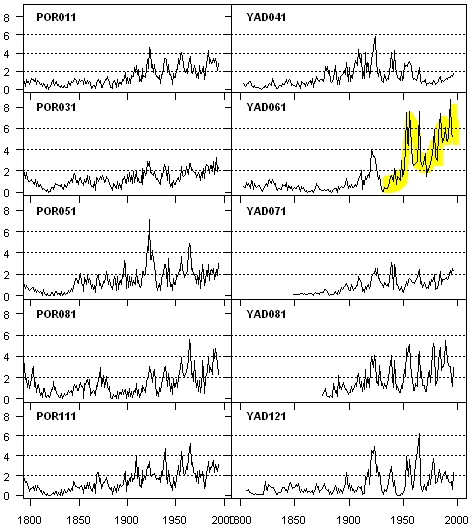Climategate: Hiding the Decline?
Posted on 22 November 2010 by James Wight
This is the third part in a series on the fake scandal of Climategate (start here).
A second set of allegations relate to the University of East Anglia Climatic Research Unit (CRU)’s paleoclimate reconstructions, which use tree rings as a proxy for temperature change. Although this is a relatively obscure branch of climate science, it was prominently featured in the Summary for Policymakers of the IPCC Third Assessment Report (TAR). Consequently, it has become a prime target for contrarians; as the Muir Russell Review puts it, they have long argued that the way CRU handled data was “intended to bias the scientific conclusions towards a specific result and to set aside inconvenient evidence.”
In what is probably the most notorious of the CRU emails, dated 16/11/1999, Jones wrote:
I’ve just completed Mike’s Nature trick of adding in the real temps to each series for the last 20 years (ie from 1981 onwards) and from 1961 for Keith’s to hide the decline.
This email is often quoted by commentators with little or no understanding of what it refers to, so it is worth taking some time to explain the context. Jones was discussing a graph for the cover of an obscure 1999 World Meteorological Organisation (WMO) report, which depicted both instrumental temperature data and reconstructed temperatures based on tree rings. The “decline” refers to the fact that some tree ring series (though not all) diverge from instrumental records in recent decades, for reasons that are not fully understood (although there are grounds for believing it is only a recent phenomenon). The “trick” was a way of presenting the data in this one particular graph, namely to truncate the tree ring data at the point when it diverged.
Anyway, contrarians take the use of the words “trick” and “hide the decline” as evidence that this was done to deceive, and this was the allegation that the inquiry examined. More generally, the contrarians claim that the divergence problem “may not have been properly taken into account when expressing the uncertainty associated with reconstructions”.
Contrarians have also accused CRU researchers (in particular their leading expert on tree ring reconstructions, Keith Briffa) of cherry-picking tree ring series that would produce a favoured result, namely that the late 20th century was warmer than the Medieval Warm Period. They allege that Briffa’s selection of an obscure tree ring chronology from the Yamal peninsula in Siberia “had an undue influence on all of the lines appearing in Chapter 6 of the 4th IPCC Report” (AR4); and that CRU withheld access to the Yamal data. And they use all these alleged flaws in CRU’s work to claim that less confidence should be placed in the conclusions of that AR4 chapter (specifically, the conclusion that current temperatures are likely the warmest in 13 centuries).
Regarding the “hide the decline” email, Jones has explained that when he used the word “trick”, he simply meant “a mathematical approach brought to bear to solve a problem”. The inquiry made the following criticism of the resulting graph (its emphasis):
[T]he figure supplied for the WMO Report was misleading. We do not find that it is misleading to curtail reconstructions at some point per se, or to splice data, but we believe that both of these procedures should have been made plain — ideally in the figure but certainly clearly described in either the caption or the text. [1.3.2]
But this was one isolated instance that occurred more than a decade ago. The Review did not find anything wrong with the overall picture painted about divergence (or uncertainties generally) in the literature and in IPCC reports. The Review notes that the WMO report in question “does not have the status or importance of the IPCC reports”, and concludes that divergence “is not hidden” and “the subject is openly and extensively discussed in the literature, including CRU papers.” [1.3.2]
As for the treatment of uncertainty in the AR4’s paleoclimate chapter, the Review concludes that the central Figure 6.10 is not misleading, that “[t]he variation within and between lines, as well as the depiction of uncertainty is quite apparent to any reader”, that “there has been no exclusion of other published temperature reconstructions which would show a very different picture”, and that “[t]he general discussion of sources of uncertainty in the text is extensive, including reference to divergence”. [7.3.1]
Regarding CRU’s selections of tree ring series, the Review does not presume to say whether one series is better than another, though it does point out that CRU have responded to the accusation that Briffa misused the Yamal data on their website. The Review found no evidence that CRU scientists knowingly promoted non-representative series or that their input cast doubt on the IPCC’s conclusions. The much-maligned Yamal series was included in only 4 of the 12 temperature reconstructions in the AR4 (and not at all in the TAR).
What about the allegation that CRU withheld the Yamal data? The Review found that “CRU did not withhold the underlying raw data (having correctly directed the single request to the owners)”, although “we believe that CRU should have ensured that the data they did not own, but on which their publications relied, was archived in a more timely way.” [1.3.2]
In summary, while the inquiry did criticize an individual graph, it found no evidence of CRU intentionally manipulating tree ring data or downplaying the associated uncertainties to mislead the public.
Next: Perverting Peer Review?































 Arguments
Arguments






























Is it maybe dumb question, but had Briffa in hand all these data below? And did he used only the YAD061, or not?

Thank you.
shveydaxx @102,
The image you present (bar the highlighting) originates with contrarian Steve McIntyre a decade ago. At the time Keith Briffa rebutted the rather silly accusations of McIntyre and that may be helpful to you in depacking McIntyre's silliness or other silliness that his interventions have spawned.